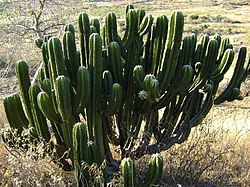Biology:Myrtillocactus schenckii
| Myrtillocactus schenckii | |
|---|---|

| |
| Scientific classification Error creating thumbnail: Unable to save thumbnail to destination
| |
| Kingdom: | Plantae |
| Clade: | Tracheophytes |
| Clade: | Angiosperms |
| Clade: | Eudicots |
| Order: | Caryophyllales |
| Family: | Cactaceae |
| Subfamily: | Cactoideae |
| Genus: | Myrtillocactus |
| Species: | M. schenckii
|
| Binomial name | |
| Myrtillocactus schenckii (J.A.Purpus) Britton & Rose
| |
Myrtillocactus schenckii, also known as garambullo or vichishovo, is a species of cacti native to Oaxaca and Puebla, Mexico. Placed in the genus Myrtillocactus, it is a member of the large and diverse family Cactaceae.[2][3]
Description
Arborescent, erect cactus, up to 2–7 m (6 ft 7 in–23 ft 0 in) tall. The main stem is short, with branches up to 10 cm (3.9 in) wide, shaped like a "chandelier", much branched near the base of the trunk, stems 6–12 cm (2.4–4.7 in) in diameter, with 6–8 ribs, bluish-green. Radial spines, whose length is from 0.5 to 1.2 cm (0.20 to 0.47 in) and from 0.5 to 0.8 mm (0.020 to 0.031 in) wide, ending in a point at the top, straight, rigid, black and greyish. Central spine between 1 and sometimes absent, between 1–5 cm (0.39–1.97 in) long and between 0.8 and 1 mm (0.031 and 0.039 in) wide, grayish or black in color and straight. Flowers, axillary, to 3.5 cm (1.4 in) wide and 3 cm (1.2 in) broad, yellowish-green to yellowish-white. Fruits, red, globose or ellipsiodal, 8–15 mm (0.31–0.59 in) in diameter, sometimes with a few weak spines.[4] Juicy red to brown pulp. Asymmetric, oval seed 1.1 to 1.5 mm (0.043 to 0.059 in) long by 8 to 1.2 mm (0.315 to 0.047 in) wide, black in color and wrinkled in appearance.[5]
Distribution and habitat
This species has a distribution restricted to the states of Chiapas, Oaxaca and Puebla.[6] Outside of Mexico, it has been registered in Guatemala. This species is characteristic of the xeric scrublands and transition areas with low deciduous forest. This species is characteristic of arid and semi-arid climate, they are generally found in gypsum and limestone soils, often with high salt content, as is the case in the Tehuacán-Cuicatlán valley.[7] It is distributed in an altitudinal range of 1,300 to 2,000 m (4,300 to 6,600 ft).[6][8] The places where the species is distributed, present a dry, arid, semi-warm climate, with a marked wet season in the summer, where the average annual rainfall is between 380 and 450 mm (15 and 18 in) and its average temperature throughout the year is of 21.2 °C (70.2 °F).[9]
Taxonomy
The first description as Cereus schenckii was published in 1909 by Joseph Anton Purpus.[10] The specific epithet schenckii honors the German botanist Heinrich Schenck. Nathaniel Lord Britton and Joseph Nelson Rose placed the species in the genus Myrtillocactus in the same year
References
- ↑ "The IUCN Red List of Threatened Species". IUCN Red List of Threatened Species. 2009-04-29. https://www.iucnredlist.org/species/152217/121526913. Retrieved 2023-09-09.
- ↑ "Myrtillocactus schenckii". Llifle.com. http://www.llifle.info/Encyclopedia/CACTI/Family/Cactaceae/8673/Myrtillocactus_schenckii.
- ↑ "Garambullo". https://www.desert-tropicals.com/Plants/Cactaceae/Myrtillocactus_schenkii.html.
- ↑ Martínez M. (1979). Catálogo de nombres vulgares y científicos de plantas mexicanas. Botas. México D.F..
- ↑ Franco Estrada, Daniel (2013). Catálogo ilustrado de cactáceas columnares del Valle de Tehuacán –Cuicatlán (Licenciat of biology thesis). Facultad de Estudios Superiores Iztacala. Universidad nacional Autónoma de México. México. p. 180.
- ↑ 6.0 6.1 Arias S. (1997). Suculentas mexicanas: Cactáceas Distribución, grupos taxonómicos y formas de vida. México D. F.: PROFEPA, UNAM y CUCC. CVS publicaciones. pp. 143.
- ↑ Stacey A. Weller. Plantas de la Reserva de la Biósfera Tehuacan-Cuicatlán. Vol. l: Especies de Puebla. Peace Corps México. USAID.
- ↑ Guzmán U. S. Arias; P. Dávila (2003). Catálogo de cactáceas mexicanas. México: UNAM/CONABIO. pp. 315.
- ↑ Anderson, Edward F.; Eggli, Urs (2005) (in de). Das grosse Kakteen-Lexikon. Stuttgart (Hohenheim): Ulmer. p. 437. ISBN 3-8001-4573-1.
- ↑ "Monatsschrift für Kakteenkunde". J. Neumann. 1908. https://www.biodiversitylibrary.org/page/35674751.
External links
Wikidata ☰ Q1956830 entry
 |






